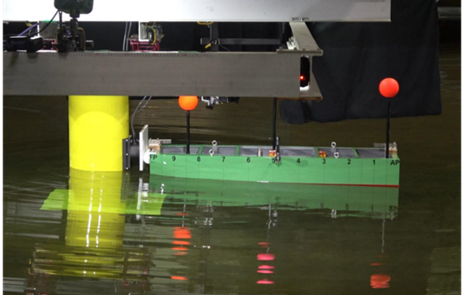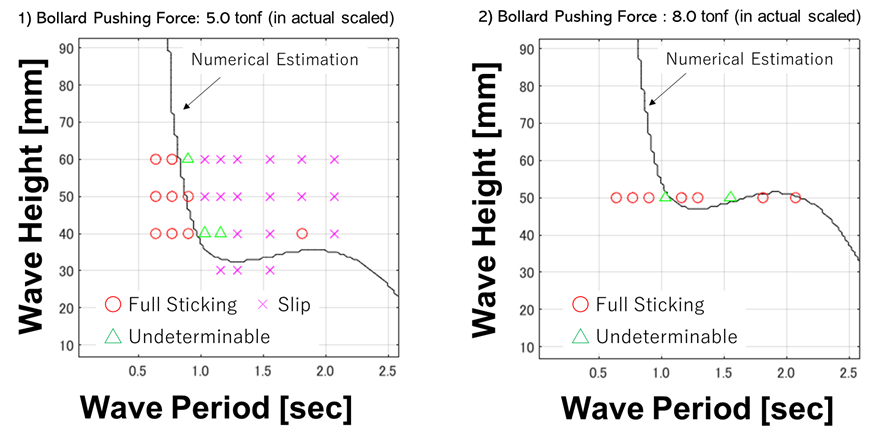Research on the Operational Evaluation of Crew Transfer Vessels (CTVs) During Transfers Operation to Offshore Wind Turbine
Research Overview
Research Overview
Minimizing offshore wind farms' maintenance and management costs is crucial for commercialization. A substantial portion of these costs is attributed to vessel expenses, particularly those related to Crew Transfer Vessels (CTVs). Transferring technicians and materials from CTVs to wind turbine towers requires the CTV to push its bow against the tower. Despite their ability to suppress wave motion during the transfer operation, CTVs have significantly different wave-induced motion compared to conventional motions. Thus, predicting CVTs' waves motion during the transfer operation is a major challenge. NMRI is researching and evaluating such transfer operations Additionally, we are developing numerical calculation methods to predict wave response characteristics obtained from experiments. Combining tank tests and numerical calculations, we aim to determine the optimal CTV hull types and evaluate operational efficiency for promising offshore wind areas in Japan.
Basic Specifications of the Crew Transfer Vessel Assumed in this Research
Model Experiments
To evaluate the transfer operation to wind turbine towers, we conducted the following tank tests in the NMRI's Ocean Engineering Basin, assuming the operational state of a bow-berthing CTV 1), 2). Figure 2 shows the reduced scale model during the experiment. We identified the hull motion in waves when the bow is pressed against the wind turbine tower. During the experiments, the assumed parameters were wave height, wave direction, wave period, wave type (regular or irregular), and the pushing force against the wind turbine tower.
Example of Model Experimental Results
Figure 3 shows the results when focusing on the stick/slip phenomenon at the bow. We found that even though we push the bow section against the wind tower, the bow section slips depending on wave height, wave period, and bollard thrust. The occurrence conditions of such phenomena are assumed to vary greatly depending on the type of CTV. In the future, we will continue our research on stick/slip boundary estimation using numerical simulations and develop evaluation tools for safe transfer evaluation of CTV.
References
- Otsubo, K.: Transfer Performance Evaluation for CTV pushing its Bow against Offshore Wind Tower, Poster Session (PS-14), Annual Research Presentation of NMRI, 22th, July, 2021 (in Japanese).
- Otsubo, K.: On the Stick/Slip Phenomenon of a Crew Transfer Vessel Pushing its Bow Against an Offshore Wind Tower During a Transfer Operation, Proceedings of 33rd International Ocean and Polar Engineering Conference, Ottawa, Canada, June 19-23, 2023.
- Otsubo, K.: Stick/Slip Phenomenon of a Crew Transfer Vessel Pushing Its Bow Against an Offshore Wind Tower During a Transfer Operation, International Journal of Offshore and Polar Engineering, 33(4), 409-419, 2023.
- Otsubo, K., Ishida, K.: Comparison of Stick/Slip Phenomena at Transfer Points Between Different Hull-type CTVs, Proceedings of 34th International Ocean and Polar Engineering Conference, Rhodes, Greece, June 16-21, 2024.
- Otsubo, K., Ishida, K.: Comparative Investigation of the Transfer Performance Between Catamaran-, Monohull- and SWATH-Type CTVs, Proceedings of 35th International Ocean and Polar Engineering Conference, Seoul, Korea, June 1-6, 2025.
- Otsubo, K., Hasegawa, K., Ishida, K.: Transfer Performance of Catamaran-Type CTV in Wind and Waves, Journal of Marine Science and Technology, 30, 528-541, 2025



